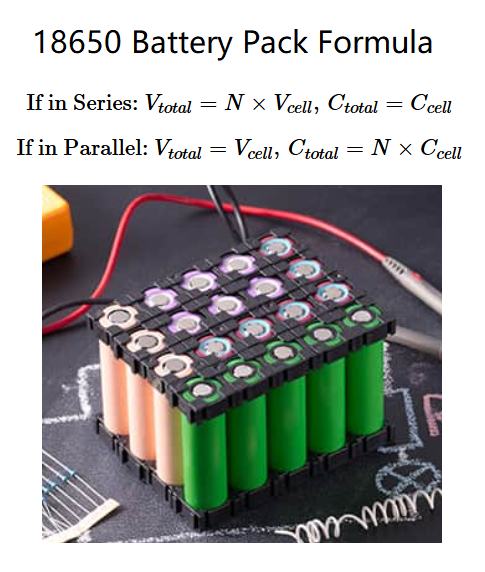Battery Pack Calculation Formula
- Vtotal – Total Voltage (V)
- Ctotal – Total Capacity (Ah)
- N – Number of 18650 Cells
- Vcell – Voltage per Cell (V)
- Ccell – Capacity per Cell (Ah)
Introduction to 18650 Battery
The 18650 battery is a common type of lithium-ion battery, named after its dimensions: 18mm in diameter and 65mm in length (the "0" indicates a cylindrical shape). It is widely used in consumer electronics, electric vehicles, energy storage systems, and more, known for its high energy density, long lifespan, and reliability.
1. Basic Characteristics
- Dimensions: 18mm in diameter, 65mm in length.
- Voltage: Nominal voltage is typically 3.7V, with a full charge voltage of 4.2V and a discharge cutoff voltage of 2.5V-3.0V.
- Capacity: Common capacity ranges from 1500mAh to 3500mAh, with some high-performance batteries exceeding 4000mAh.
- Chemistry: Primarily lithium-ion (Li-ion) or lithium iron phosphate (LiFePO4).
- Weight: Approximately 40-50 grams, depending on capacity and materials.
2. Advantages
- High Energy Density: Stores a large amount of energy, suitable for high-power devices.
- Long Cycle Life: Typically lasts 500-1000 charge cycles, with high-quality batteries exceeding 2000 cycles.
- Good Stability: Uses mature lithium-ion technology, offering high safety.
- Wide Applications: Used in laptops, power tools, electric vehicles, energy storage systems, and more.
3. Disadvantages
- Fixed Size: Limited design flexibility due to standardized dimensions.
- Requires Protection Circuit: Overcharging, over-discharging, or short circuits can cause safety issues, necessitating a protection circuit board (PCB).
- Higher Cost: More expensive compared to nickel-metal hydride (NiMH) or lead-acid batteries.
4. Main Applications
- Consumer Electronics: Laptops, flashlights, drones, etc.
- Power Tools: Drills, saws, etc.
- Electric Vehicles: Battery packs in Tesla and other EVs consist of thousands of 18650 cells.
- Energy Storage Systems: Home energy storage, solar energy storage, etc.
5. Charging and Discharging
- Charging Voltage: 4.2V (Li-ion) or 3.65V (LiFePO4).
- Discharge Cutoff Voltage: 2.5V-3.0V to avoid over-discharging.
- Charging Current: Typically 0.5C (e.g., 1.25A for a 2500mAh battery), with fast charging up to 1C.
- Discharge Current: Standard batteries support 1C, while high-rate batteries can handle 10C or more.
6. Safety Precautions
- Avoid Overcharging/Over-Discharging: Use chargers with protection circuits to prevent damage.
- Prevent Short Circuits: Short circuits can cause overheating, fire, or explosion.
- Control Temperature: Avoid charging or using in extreme temperatures.
- Regular Inspection: Stop using the battery if swelling, leakage, or performance degradation is observed.
7. Popular Brands
- International Brands: Panasonic, Samsung SDI, LG Chem, Sony.
- Chinese Brands: Lishen, BAK, CATL.
8. Purchasing Tips
- Buy from Reliable Sources: Avoid counterfeit or low-quality batteries.
- Choose Based on Needs:
- High-capacity batteries: Ideal for devices requiring long runtime.
- High-rate batteries: Suitable for high-power devices (e.g., power tools).
- Check for Protection Circuit: Ensure the battery includes a protection circuit board (PCB) for safety.
 Home
Home
 Back
Back
